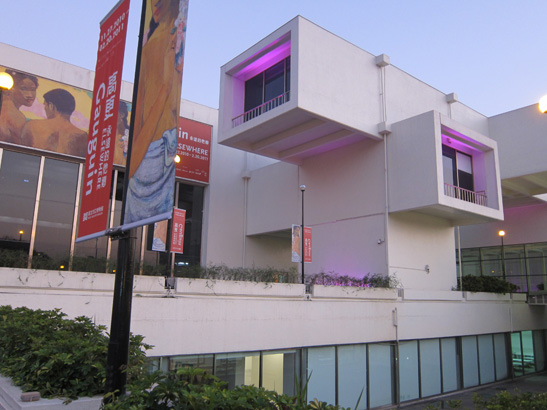|
Taipei is 65 km away from the small town where I live. It is only 30 minutes by HSR (High Speed Rail) from Hsinchu but this is an involved journey, starting with a 30-minute bus ride to Hsinchu (NT$53 / £1.12), and followed by a free shuttle bus ride from Hsinchu to nearby Jubei HSR station (HSR fare: NT$290 / £6.17). Factor in bus-waiting times and the total journey time by HSR would beat the bus journey just by 15 minutes.
Not only is the bus fare cheaper (NT$120 / £2.55), bus journeys in Taiwan are an exhilarating affair. No matter that the bus is slicing through busy towns in between the highways while having to avoid irritants such as scooters and pedestrians. Bus drivers here drive with the same determined death wish at speeds that skirt, if not cross, the legal limit.
The bus arrives at Taipei Main Station, the central transport hub in Taipei, and it is an easy ride by MRT (Mass Rapid Transit) from here to all parts of this über modern and indelibly Chinese city.

Taipei Fine Arts Museum
A free shuttle bus (a common feature of the Taiwanese transport infrastructure) takes me from Yuanshan MRT station to the Taipei Fine Arts Museum. Conceived of smooth white rectangular blocks stacked elegantly in Modernist style, the museum rises in proud and sharp contrast to the nearby Grand Hotel, built in 1952 but imitating the extravagant tradition of a Chinese palace (it featured in the 1994 film, Eat Drink Man Woman, by Ang Lee).
The current exhibition, Heart and Hand, is a rare public display of Shi Song’s works with 3 themes which reflect the artist’s lifetime interests. Now aged 64, Shi Song is considered Taiwan’s greatest living artist.
Time comprises a series of still lifes best exemplified by three paintings: a glass flask, half-filled with water, stands on a white floor, its faint shadow etched on the white wall behind it; a small glass takes its place next; and a different glass flask, also half empty, is the final subject. Their very simplicity arouses in me a rash of conflicting emotions but leaves me feeling peaceful.
Song of the Great Tree consists of a series of paintings of the life of the Buddha completed in Western-style oil on canvas. Unfolding like a grand, graphic novel, each picture evokes the Buddha’s development from thinker to religious revolutionary.
Here is the boy Prince moving through the forest with his jewel-encrusted entourage of courtiers and elephants. Later, the young Buddha - having renounced his former life - meditates under the Bodhi tree. Finally, a dying Buddha is surrounded by a group of disciples, the scene gently lit by shafts of sunlight.
Thirty-three Guanyin Bodhisattvas is a fascinating study both of the enduring attraction of the subject and the technical demands of working with brush and ink. Song Shi completed his first Guanyin as a student, and finished the most recent Guanyin a few years ago, drawing and re-drawing the same tranquil face radiating compassion for the fragility of human existence. Lines, strokes and calligraphy flow seamlessly one into the other, linking the life forces of god as subject and artist as disciple.
Even if one understands nothing of Buddhism and its precepts, to have seen these collections in their entirety is to have experienced something sublime.
Room 18
Just a few minutes’ lazy stroll from Taipei Main Station is Akari Hostel, owned and run by a friendly Taiwanese-Japanese couple. For NT$400 (£8.00), I get a clean bed in a 6-bed dorm and all manner of home comforts, including a library crammed with Japanese comics, books and DVDs.
It is where I meet Ippei, Yushi and NoName, a lean young man with piercing eyes and a quasi-Samurai haircut (short top, side bangs and a rat’s tail bound with rope). The jazz venue that I am planning to go to is closed for a private event and I am thinking of going to bed with a book at 11.00 o’clock when Ippei says, “We’re going to a club. Do you want to join us?”
We squeeze into a taxi for the ride to the Neo 19 complex adjacent to Taipei 101 (Asia’s tallest building and only beaten to the top spot in the world when Dubai’s Burj Khalifa was completed in 2010). It is nearly midnight when we reach downtown but the area is fizzing with energy and packed with shoppers, party-goers, buskers and hustlers.
We are hungry and it is too early for the club (according to Ippei), so we decamp to a Japanese diner. When I can only manage half of my udon noodles, NoName asks if he can finish it. I gawp as he drains noodles and soup down in one swift act.
Room 18 ensconced in Neo 19 is a swanky nightclub and apparently where only the coolest, slinkiest young beauties of either sex hang out. On entering the dark, womb-like interior after paying $500 (£10.63), that seems to be true.
The willowy women wear short dresses scattered with diamante and enough false lashes between them to start a small shop but the men are careful to look elaborately casual. Yushi settles for a beer while Ippei and NoName choose a fancy cocktail each. I trawl the three large rooms of the club, brushing shoulders with - who knows? - perhaps a celebrity here and there.
Each room is presided by a DJ with de rigueur headphones and offers a different music style: indie, R & B, hip hop, electronic and music I cannot begin to name, all throbbing at volumes that threaten health. Despite this, people are holding animated conversations, manicured hands wrapped round a glass or an unsmoked cigarette.
Initially, the dance floor is occupied by a handful of veterans and exhibitionists keen to display their dancing prowess. Feet tap, arms swing, knees pop and necks appear to swivel. The primeval urge to move to rhythm is powerful and years of suppression of the urge are useless in the face of such musical assault.
Eventually, I dance, if a little stiffly, my joints and muscles unused to this call to duty at an unusual pace and at this unearthly hour. I stagger home at 2.00 am while Ippei, Yushi and NoName are still warming up and downing their third whiskies.
Words and pictures by Wah-Yin Rixon. Wah-Yin Rixon lives and works in Taiwan. |











